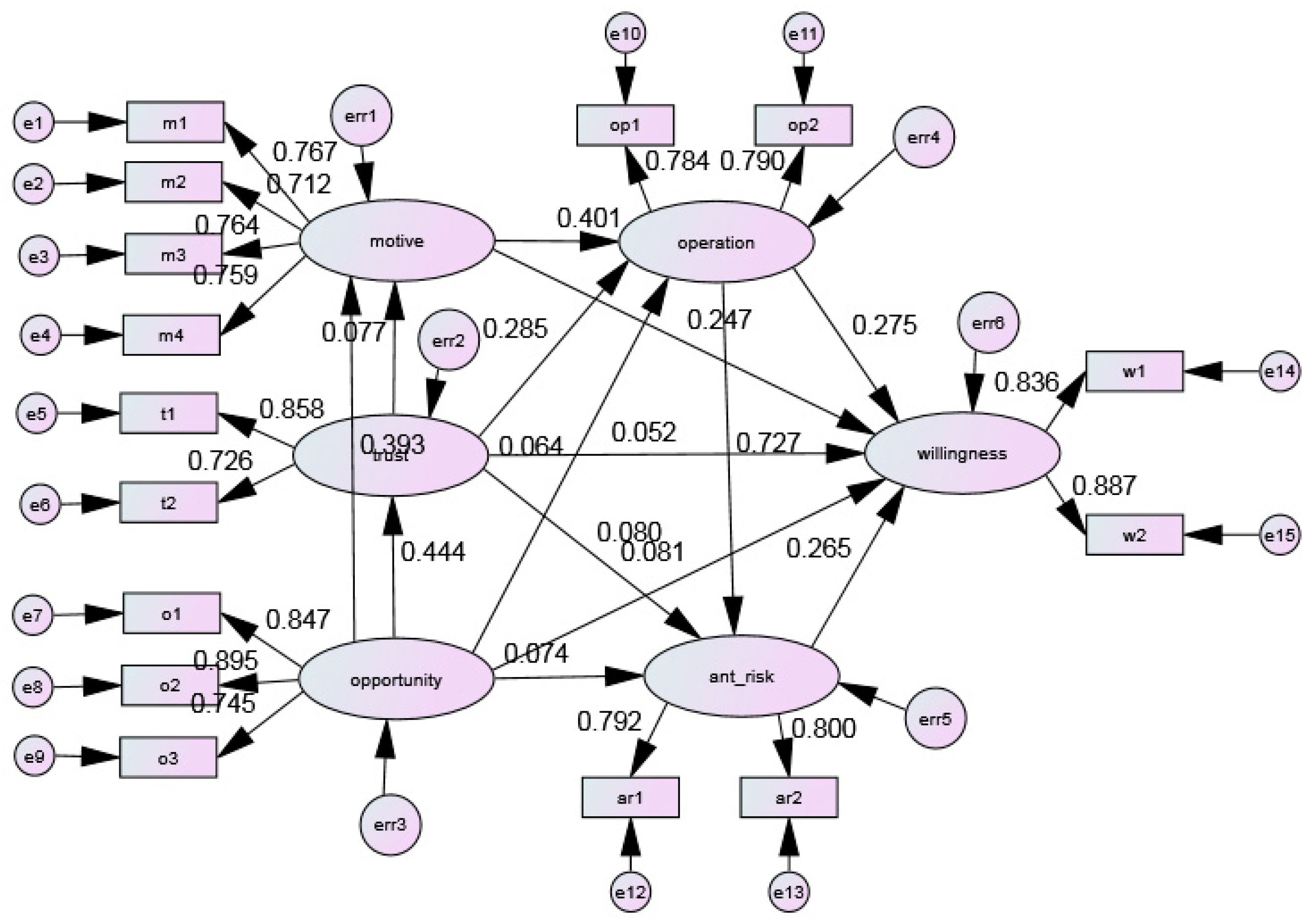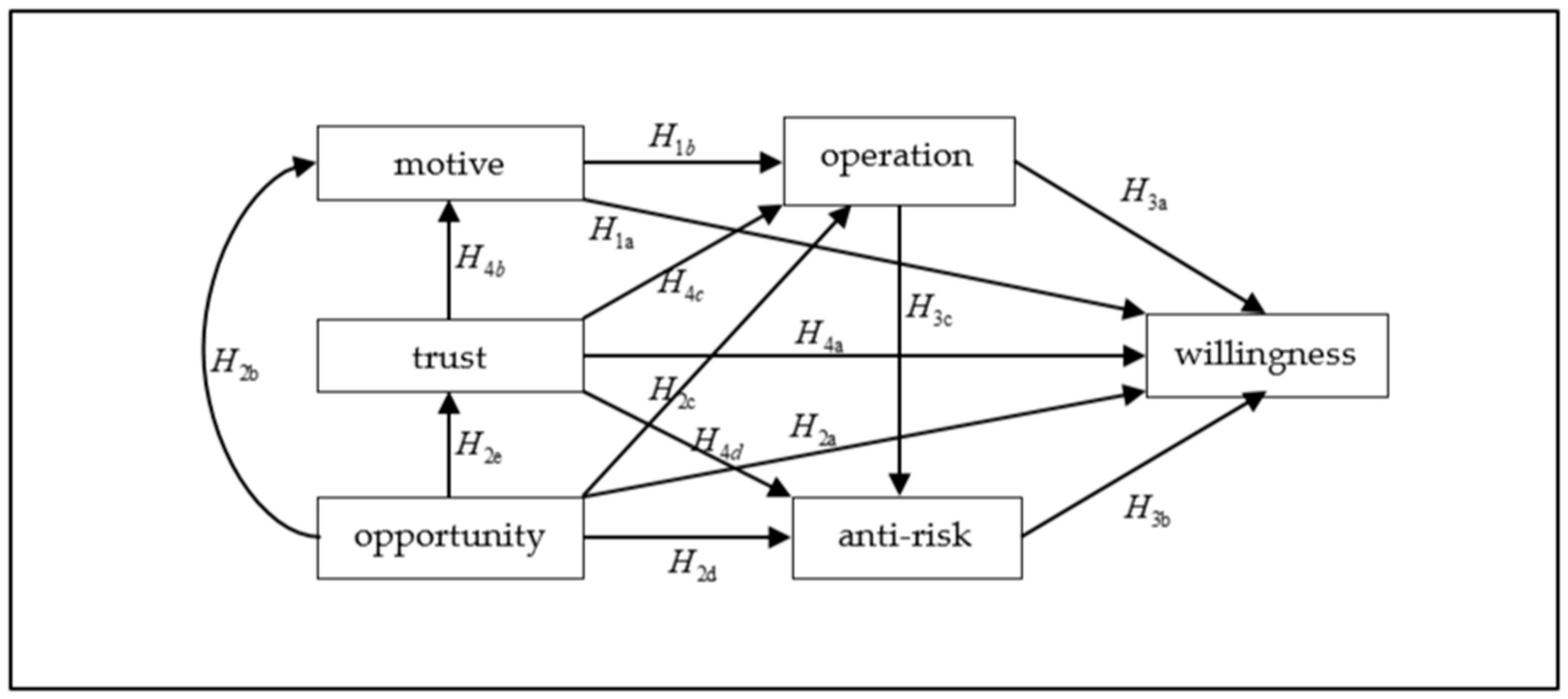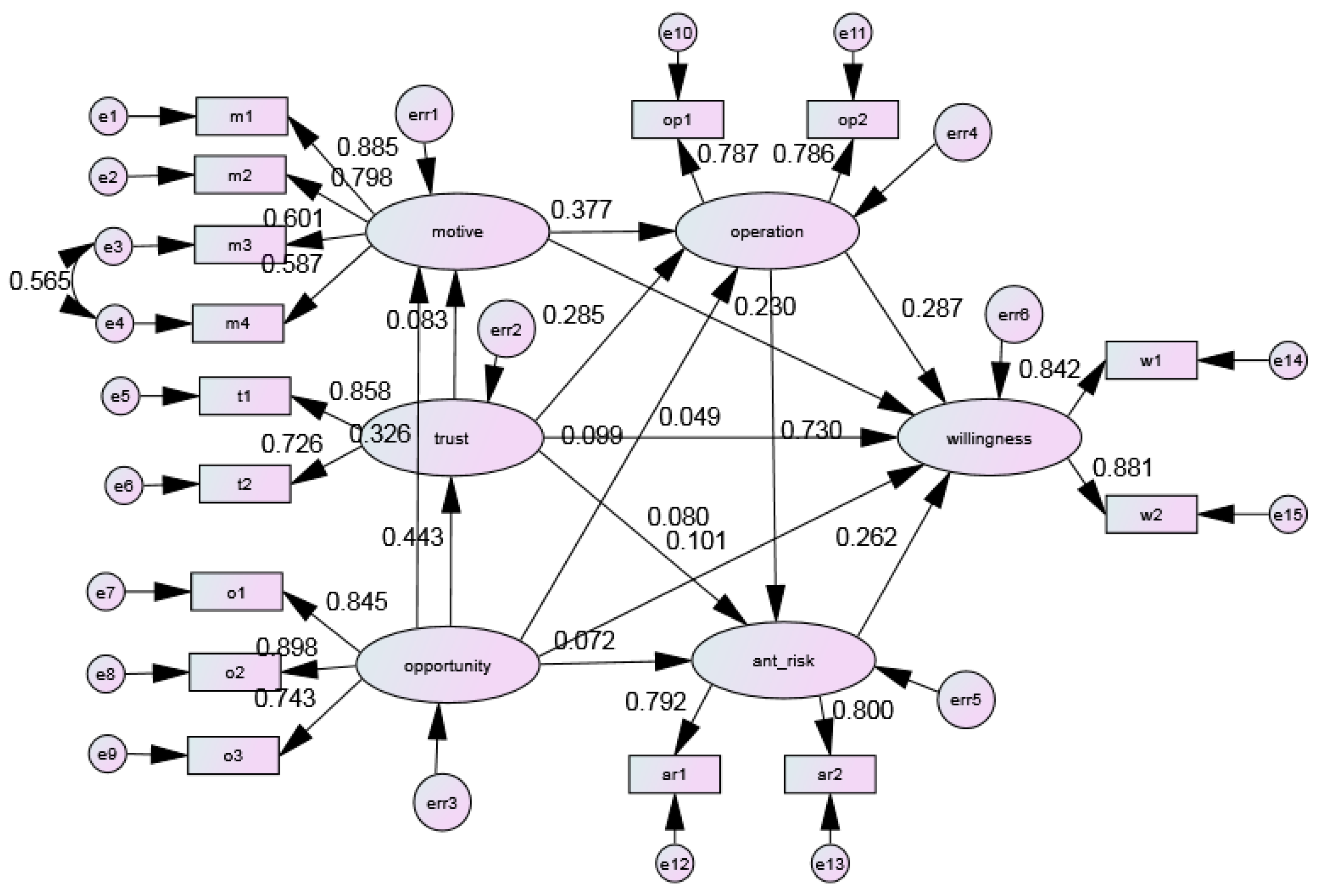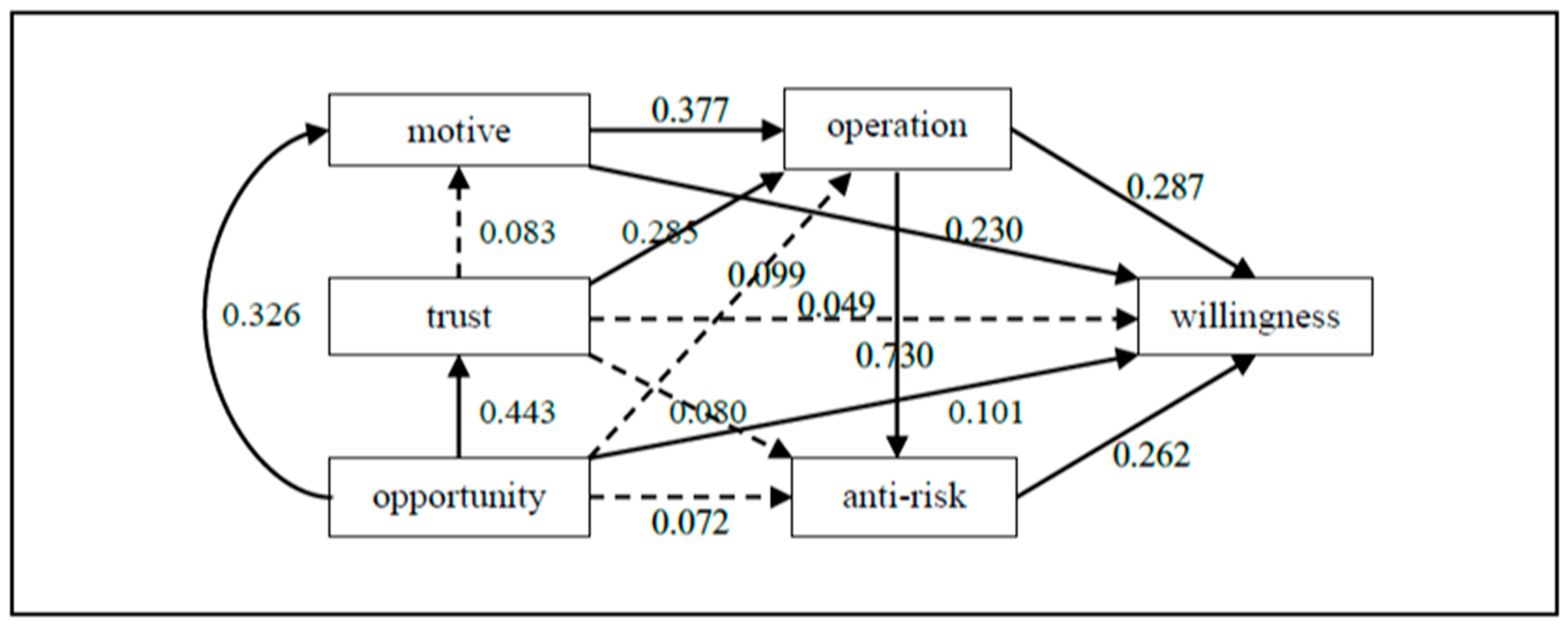Roles of Motivation, Opportunity, Ability, and Trust in the Willingness of Farmers to Adopt Green Fertilization Techniques
Abstract
1. Introduction
2. Green Fertilization Techniques in China
3. Conceptual Framework and Estimation Strategies
3.1. Theoretical Framework and Research Hypotheses
3.2. Estimation Strategies
4. Data and Descriptive Statistics
4.1. Data Source and Sampling Methods
4.2. Basic Characterization
5. Empirical Results
5.1. Validation of Model
5.2. The Results of SEM
6. Conclusions and Policy Implications
Author Contributions
Funding
Acknowledgments
Conflicts of Interest
Appendix A

References
- He, H.; Zhang, L.; Li, Q. Study on fertilization behavior of farmers and non-point source pollution in agriculture. J. Agrotech. Econ. 2006, 2–10. [Google Scholar] [CrossRef]
- Zhang, W.; Wu, S.; Ji, H.; Kolbe, H. Estimation of agricultural non-point source pollution in China and the alleviating strategies I. Estimation of agricultural non-point source pollution in China in early 21 century. Sci. Agric. Sin. 2004, 37, 1008–1017. [Google Scholar]
- Jin, S.; Zhang, H.; Wu, N. Evaluation on the implementation of zero-growth action of chemical fertilizer and pesticide use of 2016. Environ. Prot. 2018, 46, 45–49. [Google Scholar]
- Yang, Y.; Luo, X. The impact of reduction and replacement policy on famers’ willingness to adopt the organic fertilizer: An empirical analysis based on the survey data of tea growers in Hubei. J. Agrotech. Econ. 2018, 77–85. [Google Scholar] [CrossRef]
- Sun, R. Production of green agriculture: An evaluation of the process of reducing chemical fertilizer and replacing with organic fertilizer. Chongqing Soc. Sci. 2019, 33–43. [Google Scholar] [CrossRef]
- Abdulai, A.; Huffman, W. The adoption and impact of soil and water conservation technology: An endogenous switching regression application. Land Econ. 2014, 90, 26–43. [Google Scholar] [CrossRef]
- Hayati, D.; Abadi, B.; Movahedi, R.; Heidari, M. An empirical model of factors affecting farmers’ participation in natural resources conservational programs in Iran. ID—20093050058. J. Food Agric. Environ. 2009, 7, 201–207. [Google Scholar]
- Cui, X.; Cai, Y.; Zhang, A. The production willingness and influencing factors of farmers to reduce the application amount of chemical fertilizers and pesticides. Rural Econ. 2011, 11, 97–100. [Google Scholar]
- Gu, J.; Chen, B.; Xu, C.; Lu, J. Study on the impact of rural household’s factors towards the new technology adoption on rice production: Based on rural households surveys in Jiangsu province. J. Yangzhou Univ. (Agric. Life Sci. Ed.) 2007, 57–60. [Google Scholar] [CrossRef]
- Traoré, N.; Landry, R.; Amara, N. On-farm adoption of conservation practices: The role of farm and farmer characteristics, perceptions, and health hazards. Land Econ. 1998, 74, 114–127. [Google Scholar] [CrossRef]
- Gao, J.; Peng, C.; Shi, Q. Study on the high chemical fertilizers consumption and fertilization behavior of small rural household in China: Discovery from 1995-2016 National Fixed Point Survey Data. Manag. World 2019, 35, 120–132. [Google Scholar]
- Karidjo, Y.B.; Wang, Z.; Boubacar, Y.; Wei, C. Factors Influencing Farmers’ Adoption of Soil and Water Control Technology (SWCT) in Keita Valley, a Semi-Arid Area of Niger. Sustainability 2018, 10, 288. [Google Scholar] [CrossRef]
- Li, Y.; Zhang, W.; Ma, L.; Huang, G.; Oenema, O.; Zhang, F.; Dou, Z. An analysis of China’s fertilizer policies: Impacts on the industry, food Security, and the environment. J. Environ. Qual. 2013, 42, 972–981. [Google Scholar] [CrossRef] [PubMed]
- Yuan, Y.; Nomura, H.; Takahashi, Y.; Yabe, M. Model of Chinese household kitchen waste separation behavior: A case study in Beijing city. Sustainability 2016, 8, 1083. [Google Scholar] [CrossRef]
- Jiang, H.; Xu, L. Study on the main factors affecting farmers’ willingness of agricultural product production safety. J. Anhui Agric. Sci. 2010, 38, 9256–9259. [Google Scholar]
- Wu, X.; Zhang, J.; He, K.; Zhang, L. Farmer willingness to adopt rice straw returning technology and driving path. Resour. Sci. 2016, 38, 2117–2126. [Google Scholar]
- Maclnnis, D.J.; Jaworski, B.J. Information processing from advertisements: Toward an integrative framework. J. Mark. 1989, 53, 1–23. [Google Scholar] [CrossRef]
- He, K.; Zhang, J.; Zhang, L.; Wu, X. Interpersonal trust, institution-based trust and farmers’ willingness to participate in environmental governance: A case study on the reutilization of agricultural waste. Manag. World 2015, 5, 75–88. [Google Scholar]
- Prazan, J.; Theesfeld, I. The role of agri-environmental contracts in saving biodiversity in the post-socialist Czech Republic. Int. J. Commons 2014, 8, 1–25. [Google Scholar] [CrossRef]
- Bagozzi, R.P.; Dholakia, U. Goal setting and goal striving in consumer behavior. J. Mark. 1999, 63, 19–32. [Google Scholar] [CrossRef]
- Devellis, R. Scale Development: Theory and Applications, Applied Social Research Methods; Sage Publications: Thousand Oaks, CA, USA, 2003; pp. 1–216. [Google Scholar]
- Harrison McKnight, D.; Choudhury, V.; Kacmar, C. The impact of initial consumer trust on intentions to transact with a web site: A trust building model. J. Strateg. Inf. Syst. 2002, 11, 297–323. [Google Scholar] [CrossRef]
- Wu, M. Structural Equation Modeling-Operation and Application of AMOS; Chongqing University Press: Chongqing, China, 2010. [Google Scholar]
- Blazy, J.-M.; Carpentier, A.; Thomas, A. The willingness to adopt agro-ecological innovations: Application of choice modelling to Caribbean banana planters. Ecol. Econ. 2011, 72, 140–150. [Google Scholar] [CrossRef]
- Lambrecht, I.; Vanlauwe, B.; Merckx, R.; Maertens, M. Understanding the Process of Agricultural Technology Adoption: Mineral Fertilizer in Eastern DR Congo. World Dev. 2014, 59, 132–146. [Google Scholar] [CrossRef]
- Li, H. An empirical analysis of farmers’ adoption willingness on cycle agricultural technology. China Rural Surv. 2012, 2, 28–36. [Google Scholar]
- Hair, J.F.; Hult, G.T.M.; Ringle, C.; Sarstedt, M. A Primer on Partial Least Squares Structural Equation Modeling (PLS-SEM); SAGE Publications: Thousand Oaks, CA, USA, 2016. [Google Scholar]
- Breckler, S.J. Applications of covariance structure modeling in psychology: Cause for concern? Psychol. Bull. 1990, 107, 260–273. [Google Scholar] [CrossRef] [PubMed]
- Cudeck, R.; Browne, M.W. Cross-Validation of Covariance Structures. Multivar. Behav. Res. 1983, 18, 147–167. [Google Scholar] [CrossRef]
- Byrne, B.M. Structural Equation Modeling with AMOS: Basic Concepts, Applications, and Programming (Second Edition); Routledge: New York, NY, USA, 2010. [Google Scholar]
- Ma, W.; Abdulai, A.; Goetz, R. Agricultural Cooperatives and Investment in Organic Soil Amendments and Chemical Fertilizer in China. Am. J. Agric. Econ. 2018, 100, 502–520. [Google Scholar] [CrossRef]
- Wossen, T.; Abdoulaye, T.; Alene, A.; Haile, M.G.; Feleke, S.; Olanrewaju, A.; Manyong, V. Impacts of extension access and cooperative membership on technology adoption and household welfare. J. Rural Stud. 2017, 54, 223–233. [Google Scholar] [CrossRef]
- Wang, Y.; Zhu, Y.; Zhang, S.; Wang, Y. What could promote farmers to replace chemical fertilizers with organic fertilizers? J. Clean. Prod. 2018, 199, 882–890. [Google Scholar] [CrossRef]
- Adnan, N.; Md Nordin, S.; Rahman, I.; Noor, A. Adoption of green fertilizer technology among paddy farmers: A possible solution for Malaysian food security. Land Use Policy 2017, 63, 38–52. [Google Scholar] [CrossRef]



| Latent Variables | Observed Variables and Definition | Mean | Standard Error |
|---|---|---|---|
| motive | m1—Adopting green fertilization technology is beneficial to the improvement of soil quality | 4.44 | 0.705 |
| m2—Adopting green fertilization technology is conducive to improving the quality of agricultural products | 4.40 | 0.713 | |
| m3—Adopting green fertilization techniques can help increase income | 3.86 | 0.726 | |
| m3—Adopting green fertilization techniques could help save costs | 3.74 | 0.824 | |
| opportunity | o1—Government/organization has played a role in green fertilization technology information services | 3.68 | 0.908 |
| o2—Government/organization has played a role in guiding green fertilization techniques | 3.79 | 0.913 | |
| o3—Government/organization has played a role in green fertilizer purchases | 3.59 | 0.969 | |
| operation | op1—Green fertilization techniques are easy to learn | 4.04 | 0.890 |
| op2—I can solve the problems in the application of green fertilization technology | 4.19 | 0.748 | |
| anti-risk | ar1—The risks of green fertilization are controllable | 4.08 | 0.809 |
| ar2—I can withstand the risks of green fertilization technology | 4.10 | 0.792 | |
| trust | t1—The technical services brought by the government/organization prompted me to trust the technology | 3.62 | 0.777 |
| t2—I believe that the government/organization can help farmers mitigate losses when technical risks occur | 3.07 | 0.941 | |
| willingness | w1—I am willing to adopt green fertilization techniques | 4.47 | 0.820 |
| w2—I am willing to recommend green fertilization technology to my neighbors. | 4.28 | 0.818 |
| Latent Variables | Indicators | Standardized Factor Loadings | Cronbach’s α | AVE | CCR |
|---|---|---|---|---|---|
| motive | m1 | 0.7668 | 0.836 | 0.5622 | 0.8369 |
| m2 | 0.7116 | ||||
| m3 | 0.7604 | ||||
| m4 | 0.7592 | ||||
| opportunity | o1 | 0.8471 | 0.863 | 0.6911 | 0.8697 |
| o2 | 0.8952 | ||||
| o3 | 0.7446 | ||||
| operation | op1 | 0.7840 | 0.762 | 0.6191 | 0.7647 |
| op2 | 0.7896 | ||||
| anti-risk | ar1 | 0.7916 | 0.776 | 0.6337 | 0.7758 |
| ar2 | 0.8005 | ||||
| trust | t1 | 0.8472 | 0.759 | 0.6228 | 0.7655 |
| t2 | 0.7265 | ||||
| willingness | w1 | 0.8362 | 0.852 | 0.7431 | 0.8525 |
| w2 | 0.8871 |
| Model | DF | CMIN | p |
|---|---|---|---|
| Measurement weights | 9 | 13.435 | 0.144 |
| Structural weights | 23 | 26.941 | 0.258 |
| Structural residuals | 29 | 30.642 | 0.383 |
| Measurement residuals | 44 | 40.230 | 0.634 |
| Fit Index | Test Indicators | Initial Model | Modified Model | Adapted Standards |
|---|---|---|---|---|
| Absolute Fit Index | RMR | 0.025 | 0.033 | <0.05 |
| RMSEA | 0.075 | 0.043 | <0.05 | |
| GFI | 0.922 | 0.961 | >0.90 | |
| AGFI | 0.877 | 0.937 | >0.90 | |
| Incremental Fit Index | NFI | 0.919 | 0.958 | >0.90 |
| RFI | 0.888 | 0.941 | >0.90 | |
| IFI | 0.941 | 0.981 | >0.90 | |
| TLI | 0.918 | 0.973 | >0.90 | |
| CFI | 0.941 | 0.981 | >0.90 | |
| Parsimonious Fit Index | PGFI | 0.584 | 0.601 | >0.50 |
| PNFI | 0.665 | 0.684 | >0.50 | |
| PCFI | 0.681 | 0.701 | >0.50 | |
| CN | 426 | 426 | >200 | |
| CMIN/DF | 3.418 | 1.786 | 1–3 |
| Hypothesis | Standardized Regression Weights | Accept/Refuse |
|---|---|---|
| trust ← opportunity | 0.443 *** | Accept |
| motive ← trust | 0.083 | Refuse |
| motive ← opportunity | 0.326 *** | Accept |
| operation ← trust | 0.285 *** | Accept |
| operation ← opportunity | 0.099 | Refuse |
| operation ← motive | 0.377 *** | Accept |
| anti-risk ← trust | 0.080 | Refuse |
| anti-risk ← operation | 0.730 *** | Accept |
| anti-risk ← opportunity | 0.072 | Refuse |
| willingness ← trust | 0.049 | Refuse |
| willingness ← anti-risk | 0.262 ** | Accept |
| willingness ← operation | 0.287 *** | Accept |
| willingness ← motive | 0.230 *** | Accept |
| willingness ← opportunity | 0.101 * | Accept |
| Hypothesis | Organization Member | Signing Contract | ||
|---|---|---|---|---|
| Non-Member | Member | Not Signed | Signed | |
| willingness ← trust | 0.003 | 0.045 | 0.030 | 0.009 |
| willingness ← anti-risk | 0.534 *** | 0.067 | 0.535 *** | 0.060 |
| willingness ← operation | 0.147 | 0.295 * | 0.124 | 0.375 ** |
| willingness ← motive | 0.261 *** | 0.234 ** | 0.215 *** | 0.315 *** |
| willingness ← opportunity | 0.006 | 0.187 ** | 0.018 | 0.196 ** |
| CMIN/DF | 1.713 | 1.809 | ||
| RMSEA | 0.041 | 0.044 | ||
| GFI | 0.929 | 0.926 | ||
| AGFI | 0.886 | 0.890 | ||
| CFI | 0.962 | 0.958 | ||
| TLI | 0.947 | 0.941 | ||
© 2019 by the authors. Licensee MDPI, Basel, Switzerland. This article is an open access article distributed under the terms and conditions of the Creative Commons Attribution (CC BY) license (http://creativecommons.org/licenses/by/4.0/).
Share and Cite
Li, Q.; Zeng, F.; Mei, H.; Li, T.; Li, D. Roles of Motivation, Opportunity, Ability, and Trust in the Willingness of Farmers to Adopt Green Fertilization Techniques. Sustainability 2019, 11, 6902. https://doi.org/10.3390/su11246902
Li Q, Zeng F, Mei H, Li T, Li D. Roles of Motivation, Opportunity, Ability, and Trust in the Willingness of Farmers to Adopt Green Fertilization Techniques. Sustainability. 2019; 11(24):6902. https://doi.org/10.3390/su11246902
Chicago/Turabian StyleLi, Qiusheng, Fang Zeng, Hao Mei, Tianqi Li, and Dasheng Li. 2019. "Roles of Motivation, Opportunity, Ability, and Trust in the Willingness of Farmers to Adopt Green Fertilization Techniques" Sustainability 11, no. 24: 6902. https://doi.org/10.3390/su11246902
APA StyleLi, Q., Zeng, F., Mei, H., Li, T., & Li, D. (2019). Roles of Motivation, Opportunity, Ability, and Trust in the Willingness of Farmers to Adopt Green Fertilization Techniques. Sustainability, 11(24), 6902. https://doi.org/10.3390/su11246902




